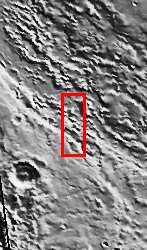
This jumble of eroded ridges and mesas occurs within Ares Vallis, one of the largest catastrophic outflow channels on the planet. Floods raged through this channel, portions of which are up to 25 km wide, pouring out into the Chryse Basin to the north. Close inspection of the THEMIS image reveals polygonal shapes on the floor of the channel system. Polygonal terrain on Mars is fairly common although the variety of forms and scales of the polygons suggests multiple modes of origin. Those in Ares Vallis resemble giant desiccation polygons that form in soils on Earth when a moist layer at depth drys out. While polygons can form in icy soils (permafrost) and even lava flows, their presence in a channel thought to have been carved by flowing water is at least consistent with a mode of origin that involved liquid water.
Note: this THEMIS visual image has not been radiometrically nor geometrically calibrated for this preliminary release. An empirical correction has been performed to remove instrumental effects. A linear shift has been applied in the cross-track and down-track direction to approximate spacecraft and planetary motion. Fully calibrated and geometrically projected images will be released through the Planetary Data System in accordance with Project policies at a later time.
NASA's Jet Propulsion Laboratory manages the 2001 Mars Odyssey mission for NASA's Office of Space Science, Washington, D.C. The Thermal Emission Imaging System (THEMIS) was developed by Arizona State University, Tempe, in collaboration with Raytheon Santa Barbara Remote Sensing. The THEMIS investigation is led by Dr. Philip Christensen at Arizona State University. Lockheed Martin Astronautics, Denver, is the prime contractor for the Odyssey project, and developed and built the orbiter. Mission operations are conducted jointly from Lockheed Martin and from JPL, a division of the California Institute of Technology in Pasadena.

 Planetary Data System
Planetary Data System













